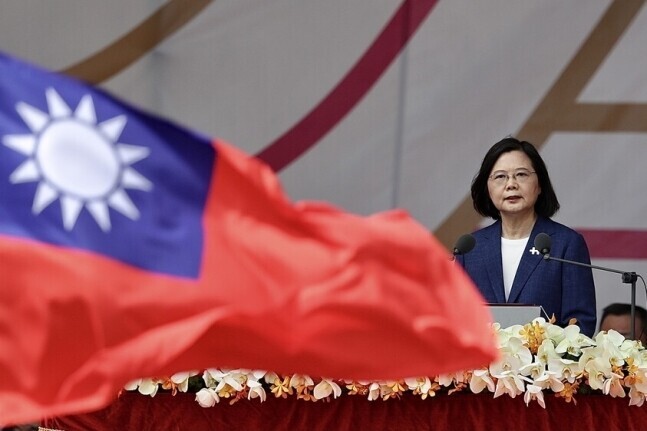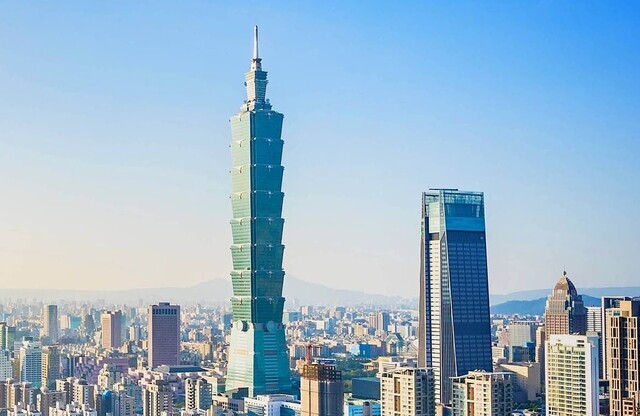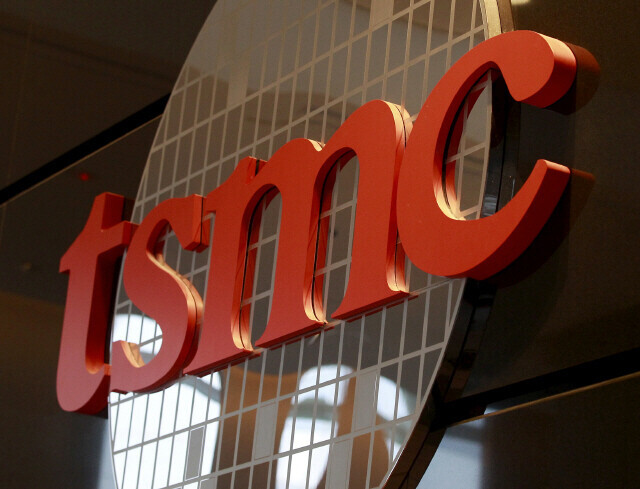hankyoreh
Links to other country sites 다른 나라 사이트 링크
Could this be the year Taiwan’s economy overtakes S. Korea’s?

“Today, Taiwan's economic performance is back in the lead of the Four Asian Tigers,” said Taiwanese President Tsai Ing-wen in a speech on Taiwan National Day on Oct. 10, 2021.
The reason that Tsai dusted off the phrase “Asian Tigers” — which hasn’t been used much since the 2000s — is because the Taiwanese economy is soon expected to catch up with that of South Korea.
The Asian Tigers refer to Korea, Taiwan, Hong Kong and Singapore, four countries that have achieved dramatic economic growth since the 1970s. Considering that Hong Kong and Singapore are city-states with a population of less than 10 million, Tsai’s remark amounts to a declaration that Taiwan will soon be overtaking Korea.
Taiwan has a population of 23 million, just 45% of Korea’s population of 51 million.

Tsai’s projection might be realized faster than expected.
In the World Economic Outlook published on Oct. 12 of last year, the International Monetary Fund (IMF) predicted that Taiwan’s per capita GDP would catch up with Korea’s in 2025. But just half a year later, in the World Economic Outlook released on March 25, the IMF said that Taiwan (US$36,051) would pass Korea (US$34,994) in that area this year, three years faster than the original prediction.
Last October, the IMF predicted that Korea and Taiwan would have identical growth rates of 3.3% this year, but in April, it revised those predictions to 2.5% for Korea and 3.2% for Taiwan. Korea’s growth rate fell more sharply than Taiwan’s, which caused the GDP projection for the two countries to change as well.
The IMF’s prediction that Taiwan will surpass Korea this year in per capita GDP, a leading indicator for comparing the two countries’ economies, was welcomed in Taipei but raised concerns in Seoul. If the prediction proves accurate, Taiwan will take the lead over Korea in the metric for the first time since 2003.
Big wins in combating COVID-19 and industry focus on electronic componentsThe key factors in Taiwan’s economic growth are thought to be its successful campaign against COVID-19 and the strong performance of its electronics industry, which is focused on semiconductors. Taiwan had posted economic growth between 1% and 3% from 2015 to 2019, before the pandemic. But even in the pandemic years of 2020 and 2021, Taiwan’s economy enjoyed major growth amid a surge in electronics exports, which account for half its total exports.
Taiwan’s success in battling the pandemic is evident from the figures.
According to information available on Our World in Data, an international statistics website, Taiwan had reported a total of 799 COVID-19 cases as of Dec. 31, 2020. By the end of 2021, a year later, its total cases only stood at 17,029. On May 3, when Taiwan was dealing with a wave of the highly infectious Omicron variant of COVID-19, its total cases had risen to 173,942.
Compare that with Korea over the same period. Korea’s cumulative COVID-19 cases stood at 61,769 at the end of 2020, 630,838 at the end of 2021, and 17.4 million as of May 3. Taiwan reported 868 cumulative deaths from COVID-19 through May 3, compared to 23,007 in Korea.
In combination with Taiwan’s unique industrial focus on electronics, the country’s successful battle against COVID-19 spurred exports. When the pandemic began in 2020, it not only inflicted a tremendous shock on the global economy but also sparked demand for home and office electronics, including smartphones, displays and computers.
In Taiwan, electronic components and communication devices and displays accounted for more than half (52.2%) of all exports as of 2021.
According to statistics provided by Taiwan’s Ministry of Finance, the value of exports of electronic components (and especially semiconductors) shot up from US$112.5 billion in 2019 to US$171.9 billion in 2021. That represents an increase of 52.8% in just two years — remarkable growth considering that the value of Taiwan’s electronic component exports only grew by 5% between 2017 and 2019, from US$107.1 billion to US$112.5 billion.

TSMC, one of the world’s leading semiconductor firms along with Samsung Electronics, typifies the success of Taiwan’s economic focus on electronic components. Controlling more than 50% of the foundry sector (which produces system semiconductors on behalf of other companies), TSMC drew even with Samsung Electronics in terms of market capitalization at the end of 2019. After a few months of jostling for first place, TSMC has remained in the lead since March 2020.
As of May 4, TSMC’s market capitalization stood at 594 trillion won, far in advance of Samsung Electronics at 455 trillion won.
Along with oil producer Saudi Aramco, TSMC is one of two Asian companies in the world’s top 10 in market capitalization. And TSMC is just one of several world-class semiconductor firms based in Taiwan, along with UMC, MediaTek and RealTek. Taiwan is also home to Foxconn, the company that manufactures the Apple iPhone.
Likelihood of a Chinese invasion of Taiwan isn’t a factor in growthAt the beginning of the pandemic in 2020, Taiwan ended up with an economic growth rate of 3.36%, the highest of any major country in the world. That outpaced not only Korea (-0.9%), which had been praised for its handling of COVID-19, but also China (2.2%), which had kept COVID-19 cases to zero for quite some time. The last time the Taiwanese economy had grown faster than China’s was all the way back in 1991.
Even while the pandemic was raging in 2021, Taiwan achieved a blistering 6.45% economic growth rate. That compared to Korea’s growth rate of 4.0% and China’s rate of 8.1%. While Korea and China were enjoying the base effect of low growth in 2020, Taiwan’s figure reflected pure growth, with no base effect.
Despite concerns that a Chinese invasion of Taiwan is more likely now than ever before, given China’s intensifying rivalry with the US, that doesn’t factor at all into Taiwan’s economic growth. The value of Taiwan’s exports to China rose 42.9% between 2019 (US$132.1 billion) and 2021 (US$188.8 billion).
In fact, China was responsible for most of the growth in Taiwan’s exports. The share of Taiwan’s total exports that are bound for China rose from 40.1% in 2019 to 42.3% in 2021. During the same period, the value of Taiwan’s exports to the US, its second-biggest market, shot up 42.0%, from US$46.2 billion in 2019 to US$65.6 billion in 2021, as the US share of Taiwan’s exports increased modestly from 14.1% to 14.7%.
In effect, Taiwan has doubled down on Korea’s tactic of relying on the US for defense and on China for the economy.

While the Taiwanese government is proclaiming its projected economic lead over Korea as a major political coup, ordinary Taiwanese are not so impressed. Taiwan’s soaring per capita GDP may give it the lead over Korea, but many Taiwanese complain that their wages and standard of living remain stagnant.
Taiwan’s minimum hourly wage this year is 168 Taiwanese dollars, or about 7,200 won (US$5.65). That’s 78.6% of the Korean minimum wage of 9,160 won.
Another objection is that since Taiwan’s economic growth has generally occurred in the electronics industry, the benefits have accrued only to workers in specific areas, and not to the public as a whole.
Taiwanese newspaper the China Times reported on Dec. 17, 2021, that citizens don’t see how economic growth has benefited them when semiconductor firms are making all the profits and other sectors are struggling.
By Choi Hyun-june, Beijing correspondent
Please direct questions or comments to [english@hani.co.kr]
Editorial・opinion
![[Column] Has Korea, too, crossed the Rubicon on China? [Column] Has Korea, too, crossed the Rubicon on China?](https://flexible.img.hani.co.kr/flexible/normal/500/300/imgdb/original/2024/0419/9317135153409185.jpg) [Column] Has Korea, too, crossed the Rubicon on China?
[Column] Has Korea, too, crossed the Rubicon on China?![[Correspondent’s column] In Japan’s alliance with US, echoes of its past alliances with UK [Correspondent’s column] In Japan’s alliance with US, echoes of its past alliances with UK](https://flexible.img.hani.co.kr/flexible/normal/500/300/imgdb/original/2024/0419/2317135166563519.jpg) [Correspondent’s column] In Japan’s alliance with US, echoes of its past alliances with UK
[Correspondent’s column] In Japan’s alliance with US, echoes of its past alliances with UK- [Editorial] Does Yoon think the Korean public is wrong?
- [Editorial] As it bolsters its alliance with US, Japan must be accountable for past
- [Guest essay] Amending the Constitution is Yoon’s key to leaving office in public’s good graces
- [Editorial] 10 years on, lessons of Sewol tragedy must never be forgotten
- [Column] A death blow to Korea’s prosecutor politics
- [Correspondent’s column] The US and the end of Japanese pacifism
- [Guest essay] How Korea turned its trainee doctors into monsters
- [Guest essay] As someone who helped forge Seoul-Moscow ties, their status today troubles me
Most viewed articles
- 1[Column] The clock is ticking for Korea’s first lady
- 2After 2 months of delayed, denied medical care, Koreans worry worst may be yet to come
- 3[Column] Has Korea, too, crossed the Rubicon on China?
- 4Hong Se-hwa, voice for tolerance whose memoir of exile touched a chord, dies at 76
- 5US overtakes China as Korea’s top export market, prompting trade sanction jitters
- 6[Correspondent’s column] In Japan’s alliance with US, echoes of its past alliances with UK
- 7All eyes on Xiaomi after it pulls off EV that Apple couldn’t
- 8[News analysis] After elections, prosecutorial reform will likely make legislative agenda
- 9Samsung barricades office as unionized workers strike for better conditions
- 10More South Koreans, particularly the young, are leaving their religions